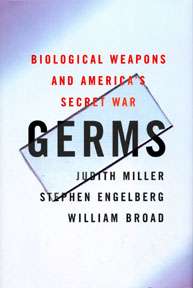Germs: Biological Weapons and America's Secret War
 | |
| Author | Judith Miller, Stephen Engelberg, William J. Broad |
|---|---|
| Country | United States |
| Language | English |
| Subject | Biological warfare |
| Genre | Nonfiction |
| Publisher | Simon & Schuster |
Publication date | October 2, 2001 |
| Media type | Hardcover |
| Pages | 382 |
| ISBN | 0-684-87158-0 |
| OCLC | 47182085 |
| 358/.38/0973 21 | |
| LC Class | UG447.8 .M54 2001 |
Germs: Biological Weapons and America's Secret War (2001) is a Simon & Schuster-published[1] book describing biological weapons, how humanity has dealt with them, and our present capabilities of handling bioterrorism. It was written by The New York Times journalists Judith Miller, Stephen Engelberg, and William Broad and was the 2001 New York Times #1 Non-Fiction Bestseller the weeks of October 28 and November 4.[2]
Overview
The nonfiction book, Germs, is a work of investigative journalism using biography and historical narratives to present issues.[3] The three authors' research is extensive, relying upon hundreds of interviews with scientists and senior U.S. officials, reviews of recently declassified documents, and reports from the former Soviet Union's bioweapons laboratories.
Summary
"Germs were always what I call the Caboose of the weapons of mass destruction train." (Judith Miller, November 18, 2001)
The book begins by recounting the 1984 salmonella poisoning in The Dalles, Oregon, caused by the followers of Bhagwan Shree Rajneesh spraying salmonella onto salad bars. There are several revelations, including how Moscow's scientists created an untraceable germ that could instruct the body to self destroy, and U.S. military plans of germ weaponry attacking Cuba in the 1960s.[1] There are descriptions of three classified U.S. biodefence projects: Project Bacchus, Project Clear Vision, and Project Jefferson.[5] Germs ends with a review of the United States's ability to deter future bio-attack.[6]
Reviews
The New York Times Book Review was favorable, though it criticized the book's tone as "somewhat alarmist".[3] BusinessWeek's review also generally favorable, though it mentioned some conflicted views on bioterrorism.[6] In The Guardian's book review by British psychiatrist Simon Wessely, he cautioned against panic, stating that biological weapons can produce destruction through fear, giving the biodefense industry "the equivalent of a blank cheque".[7]
Adaptations
On November 13, 2001, the science TV series Nova aired an episode entitled Bioterror. Two years in the making, it chronicled Miller, Engelberg, and Broad's research and investigation into biological weapons.[8]
References
- 1 2 "Germs Biological Weapons and America's Secret War". simonandschuster.com. Retrieved 2009-02-23.
- ↑ "The New York Times Best Seller List" (PDF). hawes.com. November 4, 2001. p. 2. Retrieved 2009-02-23.
- 1 2 Rose, Gideon (October 14, 2001). "No Place to Hide". nytimes.com. Retrieved 2009-02-23.
- ↑ "Judith Miller". virginia.edu. Retrieved 2009-02-23.
- ↑ Enemark, Christian (April 24, 2007). Disease and Security (GoogleBook ed.). Routledge. p. 173. ISBN 0-415-42234-5.
- 1 2 Arnst, Catherine (October 15, 2001). "Bio-Terrorism under the Microscope". businessweek.com. Retrieved 2009-02-23.
- ↑ Wessely, Simon (October 10, 2001). "Germs: Biological Weapons and America's Secret War". guardian.co.uk. Retrieved 2009-02-23.
- ↑ Collins, Rocky (November 8, 2001). "About the Program Watch NOVA's Bioterror: Tuesday, November 13 at 8:00 p.m.". pbs.org. Retrieved 2009-02-23.